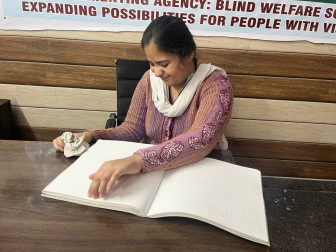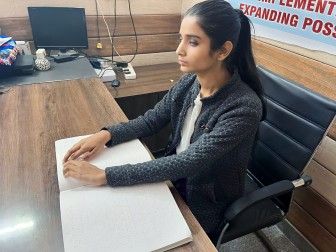The pursuit of inclusive design aims to create environments that accommodate the diverse needs of all individuals, including those who are visually impaired. Recent innovations in housing design reflect a growing commitment to enhancing accessibility and independence for visually impaired individuals. This blog explores some of the latest advancements in housing that cater specifically to the needs of this community, focusing on how these innovations are reshaping living spaces to be more inclusive and functional.
Smart home technology has revolutionized how visually impaired individuals interact with their living spaces. Voice-activated assistants like Amazon’s Alexa and Google Home allow residents to control lighting, heating, and appliances using simple voice commands. These technologies can be integrated with other smart devices to create a fully accessible environment. For instance, smart doorbells with audio notifications can inform residents when someone is at the door, while smart thermostats can be programmed to adjust temperatures automatically, ensuring comfort without manual adjustments.
Incorporating tactile and auditory cues into housing design is essential for navigating and orienting within a space. Innovations such as textured floor surfaces, raised tactile markers, and audible navigation aids help visually impaired individuals move safely and independently. For example, floor patterns with different textures can guide residents through rooms and corridors, while auditory signals can indicate the location of important features like elevators or emergency exits. These design elements enhance spatial awareness and help in creating a safer living environment.
Kitchens and bathrooms are critical areas where accessible design can significantly impact daily living. Modern innovations include adjustable-height countertops, touch-sensitive controls, and accessible storage solutions. For example, roll-under sinks and countertops provide easy access for wheelchair users, while touch-sensitive faucets and appliance controls reduce the need for manual manipulation. Additionally, auditory feedback systems can be installed in kitchen appliances to provide verbal cues about cooking times and settings, making these tasks more manageable for visually impaired individuals.
Lighting is a crucial aspect of inclusive design, and recent advancements focus on creating environments that cater to varying levels of vision. Adaptive lighting systems, which adjust based on ambient light conditions and time of day, can help visually impaired residents navigate their homes more effectively. For instance, dynamic lighting that changes in brightness and color temperature can improve contrast and reduce glare. Additionally, task lighting with adjustable intensity and color can aid in activities like reading or cooking, making these tasks more accessible.
Interactive home navigation systems are another exciting development in inclusive design. These systems use technologies such as GPS, RFID, and Bluetooth to provide real-time guidance and feedback within the home. For example, wearable devices or mobile apps can offer audio directions to help residents locate specific rooms or objects. Some systems also integrate with smart home technology to provide voice-guided navigation and control, creating a more intuitive and user-friendly experience.
Modular and adaptable design features allow for greater flexibility in housing layouts, accommodating the changing needs of visually impaired individuals over time. Modular furniture and adjustable features can be reconfigured to suit different requirements, such as accommodating mobility aids or creating additional space for personal preferences. For example, adjustable shelving and movable partitions can be customized to enhance accessibility and functionality, ensuring that living spaces remain practical and comfortable as needs evolve.
Safety is a paramount concern in inclusive design, and recent innovations focus on minimizing risks and enhancing security for visually impaired residents. Technologies such as smart smoke detectors with auditory alerts, emergency call systems, and fall detection sensors contribute to a safer living environment. Additionally, advanced security systems with voice-activated controls and real-time video feeds can help residents monitor their surroundings and respond to potential threats more effectively.
Inclusive design also extends to fostering community and social integration. Innovations in housing often include communal spaces that are accessible and welcoming to all residents, promoting social interaction and engagement. Accessible design features in common areas, such as tactile maps, audible announcements, and inclusive recreational facilities, contribute to a sense of community and support for visually impaired individuals.
The latest innovations in housing design reflect a growing commitment to creating environments that are accessible, functional, and inclusive for visually impaired individuals. From smart home technology and tactile navigation aids to customizable living spaces and enhanced safety features, these advancements are reshaping how we think about housing for those with visual impairments. By embracing inclusive design principles, we can create living spaces that not only meet the needs of visually impaired individuals but also enhance their independence, comfort, and overall quality of life. As we continue to innovate and explore new solutions, the goal remains clear: to build a world where everyone can live confidently and comfortably, regardless of their visual abilities.
By contributing to our feature donation campaigns, you are not just supporting us,
you are fostering independence, education, and accessibility for the people with blindness.
We are providing free shelter, food and educational support to the abandoned visually impaired girls residing at BWS.
₹1146562
raised of ₹2000000 Goal
57%
3 Days left
573 Supporters
Maa and Papa weren’t the happiest when I was born. They thought I was a burden to them.
₹769463
raised of ₹2000000 Goal
38%
3 Days left
590 Supporters
The Walking Canes have proved a useful tool to millions of blind people in navigating their environments with confidence and ease.
At our organization, we provide a nurturing environment for visually impaired girls, helping them lead fulfilling lives despite their challenges.
The following stories highlight the transformative journey of these remarkable individuals within our organization.

Hailing from Delhi, Sneha came to Blind Welfare Society in July 2023.
.jpeg)
Hailing from a small village of Gwalior district, Madhya Pradesh, Archana came to Blind Welfare Society in July 2023

Chhavi’s journey is a testament to the transformative power of education and the invaluable support provided by the Blind Welfare Society.